| Author | Message | ||
| thewitt
New Username: thewitt Post Number: 1 Registered: 4-2010 |
Hi Guys First time here as I'm a first time owner. I recently (last night) acquired a 1985 Persuader. I was very happy to bring her home and make her mine. I do my own set-ups and am quite well versed at all aspects of bass maintenance. What I don't know how to remedy - There is a problem with the string / bridge alignment. It seems the bridge is 1/16" to the treble side. I've adjusted the truss rods, raised the action, adjusted the post holes for the bridge... Still no luck. Anyway to make this better? Thanks in advance 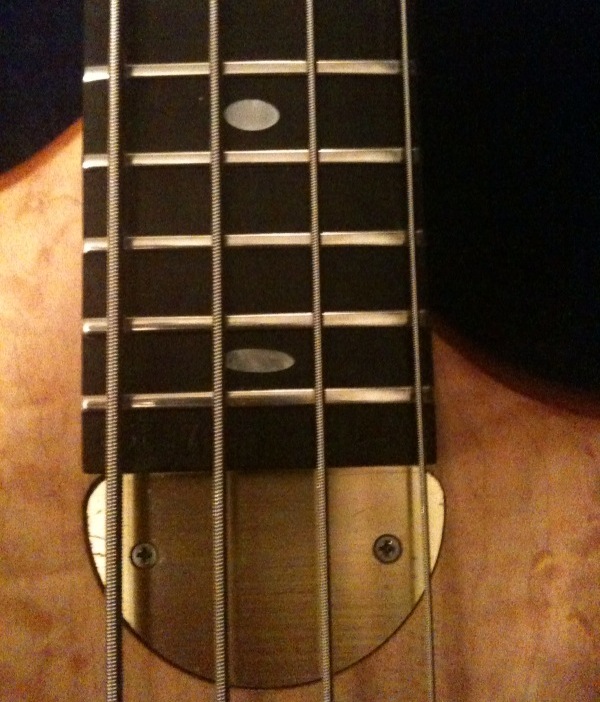 (Message edited by thewitt on April 20, 2010) (Message edited by thewitt on April 20, 2010) | ||
| adriaan
Moderator Username: adriaan Post Number: 2466 Registered: 6-2002 |
Hi Timothy, welcome to the Club! Congrats on the Persuader, and let's see if we can address the problem with the alignment. First of all, please check this classic thread, Joey's Post on Setting Up Your Bass. Alembics have some set-up features that not everyone is familiar with, but that give you a lot of control. Second, could you post pics of the (adjustable) nut and bridge, from the side and from the top? You say you adjusted the post holes for the bridge, as in drilling new holes? | ||
| lembic76450
Advanced Member Username: lembic76450 Post Number: 210 Registered: 5-2002 |
I would suggest a pic of the bridge also. Could this be from a previous owner cleaning the bridge and not putting it back together properly? Kenn R. | ||
| sonicus
Senior Member Username: sonicus Post Number: 857 Registered: 5-2009 |
I can see what you are referring to . Perhaps as the above post suggests check the slots cut in the bridge saddles for proper location . Perhaps new ones could be available from Alembic or a replacement bridge. | ||
| dadabass2001
Senior Member Username: dadabass2001 Post Number: 1399 Registered: 6-2002 |
There does appear to be more space between the D and G strings than there is between the A and D (and perhaps the E and A string spacing also). Photos and measurements of the bridge and saddles would quantify the difference. Mike | ||
| mike1762
Senior Member Username: mike1762 Post Number: 515 Registered: 1-2008 |
Try swapping the 1st and 4th saddle. I suspect the bridge has been disassembled at some point (they're more complicated than they look and it's easy to put it back together wrong). I can't imagine the bass got out of the shop that badly misaligned. | ||
| sonicus
Senior Member Username: sonicus Post Number: 859 Registered: 5-2009 |
mike1762 , Your post # 515 above makes perfect sense to me as well. | ||
| thewitt
New Username: thewitt Post Number: 2 Registered: 4-2010 |
Hi All Thanks so much for all the positive replies. What a great community. I've taken some more photos as suggested as well as read through the set up guide. To hit some specific points above, I'll go in order: >You say you adjusted the post holes for the bridge, as in drilling new holes? No, sorry if that's the wrong term. I have not drilled anything on this beautiful bass. The height of the bridge post anchors (correct term?) can be adjusted up and down, inside the body. I've tried making one high and one low. That made no difference. > Could this be from a previous owner cleaning the bridge and not putting it back together properly? I've inspected this compared to other Alembic bridges and it appears correct. >Perhaps as the above post suggests check the slots cut in the bridge saddles for proper location They do have the proper size slot for the appropriate string. >There does appear to be more space between the D and G strings than there is between the A and D (and perhaps the E and A string spacing also). Have a look at the photos - Check the inlays as shown at the 17th fret. You'll see that all 4 strings are mis-aligned. >Try swapping the 1st and 4th saddle. That wouldn't work as the slot sizes are different. The nut appears just fine to me. The spacing is just what you would expect. Perhaps replacing the saddles is all that can be done? I was wondering what you can do with that complicated looking bridge? :-) Thanks again for your time and input. 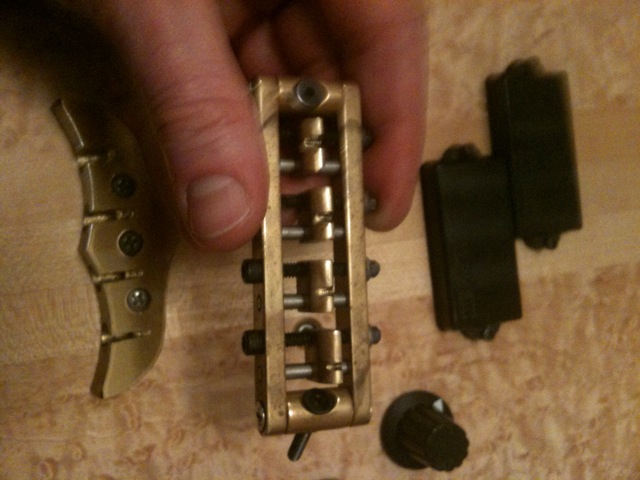 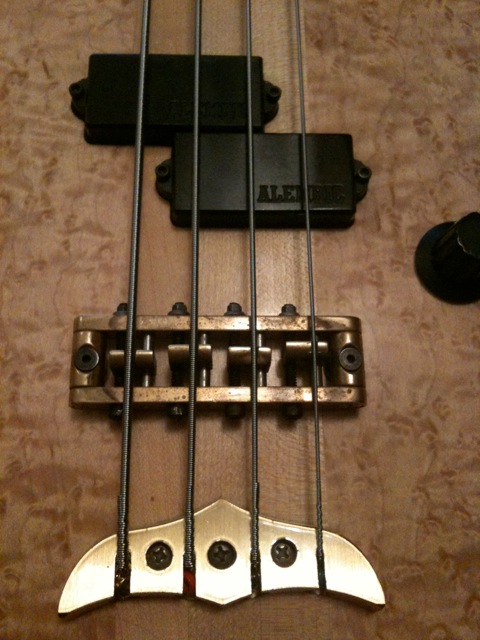 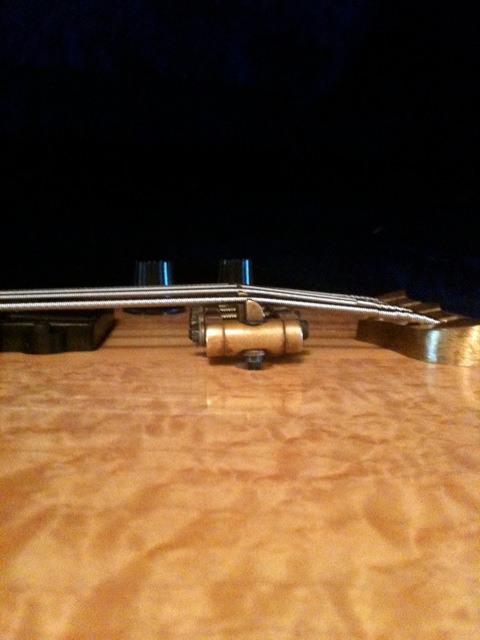 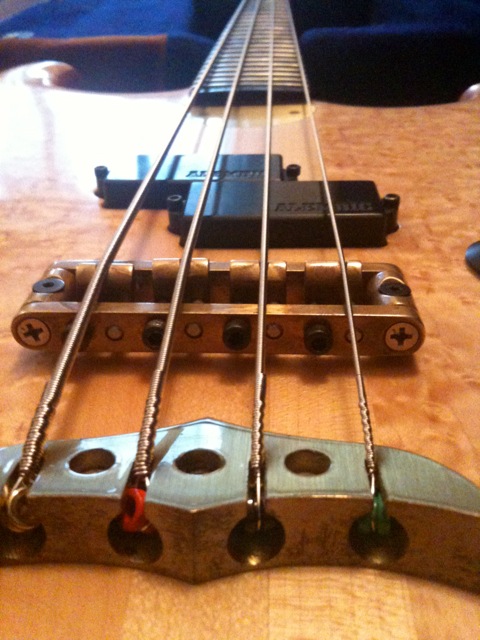 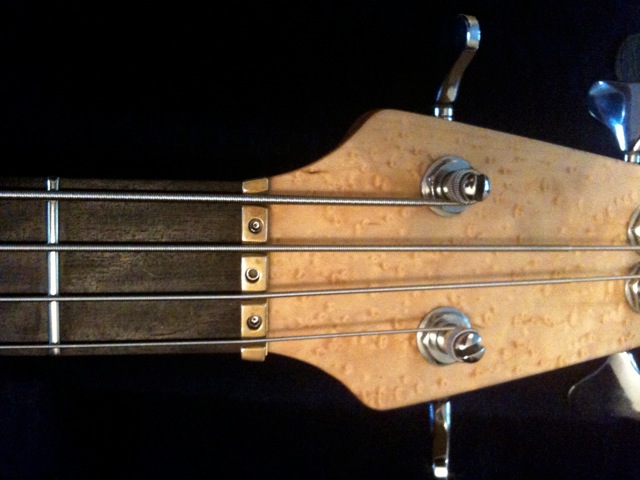 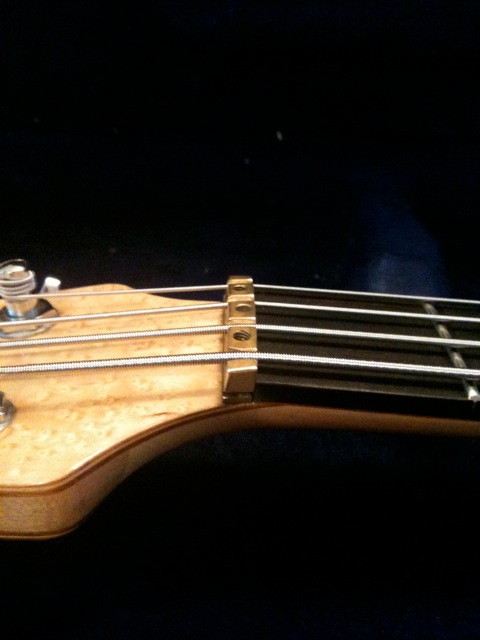 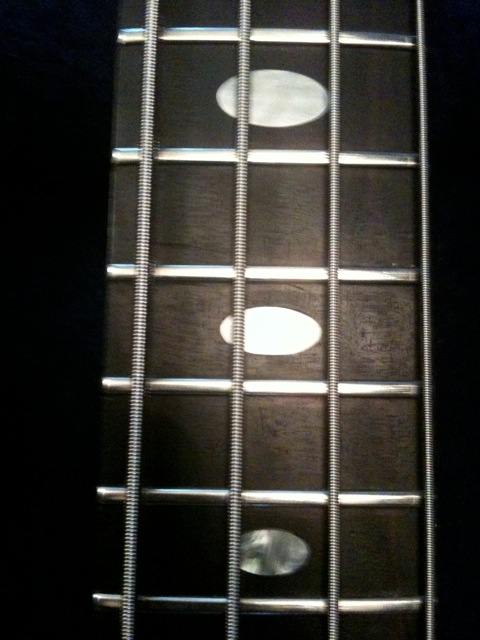 | ||
| mica
Moderator Username: mica Post Number: 6711 Registered: 6-2000 |
I would suggest replacing the saddles. There's no way to know if it was done once before, but I suspect it because I've never seen an offset like you're showing leave the factory. A lot can happen in 25 years! You could reslot the existing saddles by cutting the new slot adjacent to the existing slot. It's not ideal, but it could get you up and running. If you want to order saddles, call us at 7075232611 to place an order over the phone. | ||
| mike1762
Senior Member Username: mike1762 Post Number: 516 Registered: 1-2008 |
Duh... I forgot about the slot sizes. Is it possible that the "D" and "G" saddle are swapped? It looks like the slot in the (current) "G" saddle is more lateral than the slot in the (current) "D" saddle. If they got swapped several years ago, the strings may have "refilled" the slot in what was once the (original) "G" saddle. My only other thought (and I don't think it would make any difference): you could try taking the bridge apart and rotating the frame 180 degrees (DON'T turn it upside down... there IS an up side and a down side). I suspect you're going to have to replace the saddles (as Mica said). | ||
| thewitt
New Username: thewitt Post Number: 3 Registered: 4-2010 |
Hi Mike Thanks for your thoughts. No 'Duh' needed (maybe a D'oh!?). I don't think any of the saddles are swapped. The slots are perfectly sized for each string and even at that, it's not just the D and G strings. Also, it doesn't look like you can rotate this bridge. I thought of that, looked at it and saw that it has 2 pins per saddle (one to align that is just a post and one that is a screw). So to do that would mean turning all the saddles backwards - With the rounded edge toward the strings playing area. I bet that would be a bit sitar-like. :-) I think Mica has the final word - And Sonicus said it first - Replace the saddles. I'll call tomorrow and see what we can do. Goodnight! (Message edited by thewitt on April 21, 2010) | ||
| dfung60
Senior Member Username: dfung60 Post Number: 410 Registered: 5-2002 |
I'm not sure the fix will be this simple. It looks like the strings are running straight and parallel from the tailpiece to the bridge. If you recut the G saddle to fix this problem, then the run from the bridge to tailpiece won't be a straight shot. This will work, but it really begs the question if something else is wrong. I could be wrong, but I would guess that the saddle slotting procedure is to string up the bass and let the natural string position identify the point to slot the saddle. The positions that this bridge is slotted at looks very similar to how mine look. You might want to stop reading at this point. It looks like the spacing at the nut is a little tight on the G side, but not way off. So, I think what you probably want to do is get a long (3') straightedge and see if there's a problem with the straightness of the neck (gulp). I think there might be a warp in the neck that's putting the headstock to the E side. You can see in the pictures that the strings aren't running over the centers of the inlays either, another sign that something is seriously wrong. If the neck has been refinished or feels assymetrical it's possible that the neck profile was shaved down too much, although it would be weird to shave a neck's width like this. If somebody was trying to make the neck narrower, they would have to take it off the G side because of the markers on the E side. If the neck is warped like this, a fix is pretty complicated. If you can tolerate narrowed spacing you can recut the saddles and either live with non-parallel runs to the tailpiece or get a new tailpiece made. I hope I'm wrong on this one. David Fung | ||
| cozmik_cowboy
Senior Member Username: cozmik_cowboy Post Number: 686 Registered: 10-2006 |
OK, the G-string isn't lined up, but how are the pasties? (ba-dum!) But seriously, folks, now that David says that, I'm noticing that the nut looks like it extends a tad past the G-string side of the fret board. Here's hoing that's just a trick of the camera angle! Peter | ||
| davehouck
Moderator Username: davehouck Post Number: 9249 Registered: 5-2002 |
Here's what Peter is looking at. 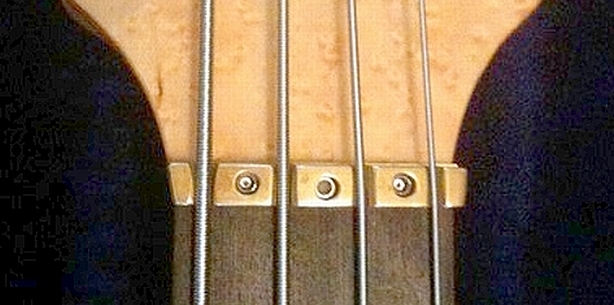 It might be the camera angle. Hard to tell. It looks like the camera angle was not exactly straight on. Timothy, does it look like this in person? Is the G end of the nut sticking out over the edge of the neck, or are both ends flush with the neck? | ||
| artswork99
Moderator Username: artswork99 Post Number: 1087 Registered: 7-2007 |
You know the A, D and G slot (especially D and G) in the nut also look very wide and deep. (Message edited by artswork99 on April 22, 2010) | ||
| thewitt
New Username: thewitt Post Number: 5 Registered: 4-2010 |
Camera angle it is. That silly iPhone makes it tough to hold it still, keep your hands out of the light source and click the button. You can see the angle by noting the treble side adjustment screw. I tried hard to get a good shot, but failed. The nut is just fine. As is the neck. No shaving, refinishing or warping. Just to address David's post, as he was kind enough to take the time: It isn't just the G saddle that will be replaced, it's all of them. So I won't be changing the string spacing, just moving them over (about) 1/16". What Mica wondered is if they were replaced at an earlier point and slotted incorrectly. I don't know, I'm new to this bass and it's history is unobtainable. I think your suggestion of how to mark the saddles for cutting is correct, and I'll do just that. Thanks for the input guys. | ||
| thewitt
New Username: thewitt Post Number: 6 Registered: 4-2010 |
Thanks to all at Alembic, my new saddles are in hand. Nice! On a side note, when putting the bridge together, the new saddles are far more shiny than the bridge itself, so I went looking for a way to clean the rest of it. Digging around under my sink I found a bottle of easy-off cleaner for glass top stove. I put the bridge parts on the stove top and gave them a spray. Wow - That was easy! I'm sure this isn't recommended for newer parts, but for this old girl - If there was a lacquer finish, it's long gone. It worked well enough I put some on a cloth and shined up the nut too. See the before and after. 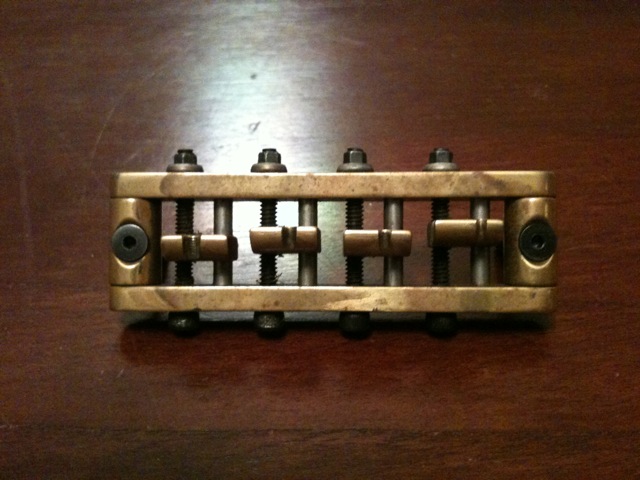 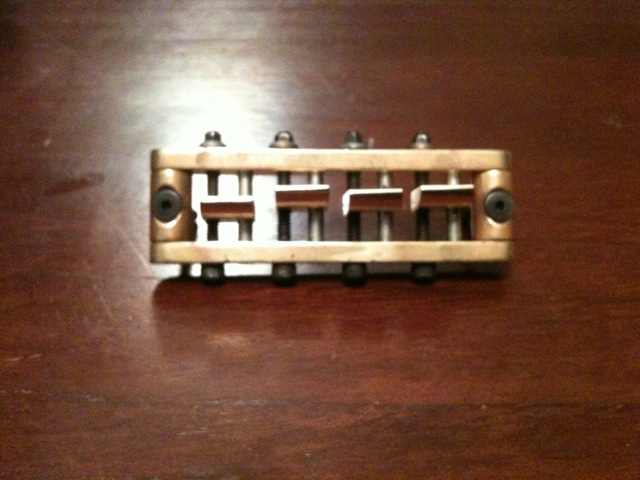 (Message edited by mica on May 11, 2010) | ||
| edwin
Senior Member Username: edwin Post Number: 624 Registered: 5-2002 |
Nice! Flitz metal polish does the job very well. Enjoy the new improved string spacing! | ||
| terryc
Senior Member Username: terryc Post Number: 1188 Registered: 11-2004 |
you could use a dremel type tool with the polishing brushe and mops along along with a paste polish(Solvol Autosol in the UK which is the same as Flitz in the USA) If there is still old laquer you can use the same tool with the brass brush attachment before polishing. You could re laquer after you got the desired bright efect | ||
| lbpesq
Senior Member Username: lbpesq Post Number: 4415 Registered: 7-2004 |
How does one "re laquer"? Bill tgo | ||
| adriaan
Moderator Username: adriaan Post Number: 2477 Registered: 6-2002 |
As far as I'm aware, on most Alembics with plain brass hardware, only the tail piece is lacquered. | ||
| fc_spoiler
Senior Member Username: fc_spoiler Post Number: 1117 Registered: 5-2006 |
That's for the older Alembics I think... On my fretless (2006) only the truss rods cover is lacquered, none of the hardware on my Elan (1990) was lacquered when I got it and both my Spoilers (1983/1988) had a lacquered tailpiece (though I'm not 100% sure 'bout the '83) Imho it's best left without finish, I think there are some topics here and I seem to remember something about hairspray. I leave the hardware unfinished and give it a good polish before I take pictures or before a big gig. Edit: If you decide to relacquer, don't use powder coating (!) check the showcase section (my '88 Spoiler) to see why, I'll post new pictures next week. (Message edited by fc_spoiler on May 12, 2010) | ||
| lbpesq
Senior Member Username: lbpesq Post Number: 4416 Registered: 7-2004 |
I think the "hairspray" rememberance is the trick with Alberto VO5 that I read somewhere around here a few years ago. After polishing brass, I rub on a tiny amount of VO5 (a women's hair product that comes in a tube that my mom used back in the 60's - the unique smell evokes lots of memories for me). It helps the brass stay shiny longer. Bill, tgo | ||
| bigredbass
Senior Member Username: bigredbass Post Number: 1391 Registered: 9-2002 |
OK, Bill, here's the 'Heloise' list: Yes, Alberto VO5 (in the gold toothpaste tube) is a great shine-keeper after you polish the brass bits. Completely organic, it's harmless to electronics and finishes, and will keep the shiny bits shiny a lot longer, put on just a thin film. My favorite wonder-lube for saddle threads, wiggle sticks, allen screws, etc., is called BreakFree CLP. You find it at most any firearms store, or Wally World or some other big box stores. Dose the selected parts with this and they will be virtually sweat, beer, and rust proof in most cases. Mil-spec, standard issue from Uncle Sam for everything from Berettas to howitzers, it's really fine. And it's also harmless to finish and electronics. I've settled on an auto parts answer to brass polish: I use Eagle One Never-Dull Wadding Polish. Really strange, it's a can full of a roll of fuzzy stuff impregnated with this polish. Real old school. Pinch off a piece, and it shines up the brass RIGHT NOW. Make a couple of passes with it, wipe off the the remnant black stuff with a clean cloth, then a little VO5, you're done. The can has several prompts about not smoking around this stuff. I have managed to get a little bit on the finish and saw no ill effects, but I would stay off the finish if possible. And if you have poly-finished, colored instruments like me, I use Mother's waxes and polishes for guitar wax. Remember in auto lingo, polish has fine abrasives, wax is liquid wax only. Car wax is also fine for keys or gold plated parts where you can't use brass polish. I still however, have not found any suitably post-hippie, organic lemon oil here in Nashville, so I have no guidance there. Now, where's my Martha Stewart magazine . . . . J o e y | ||
| terryc
Senior Member Username: terryc Post Number: 1191 Registered: 11-2004 |
Okay..re laquering. Prep. For a thorough job you could dismantle the bridge completely. Remove old laquer with brass brush attachment to Dremel tool OR liberally coat parts with chemical paint stripper(use rubber gloves..this stuff is extremely corrosive to skin) and leave. Old laquer will bubble up. Wash thoroughly and inspect. It is essential all traces of old laquer is removed. Repeat procedure until is is all gone. There is no need to laquer the steel pins or threaded bolts..just the brass. Polish brass with chosen product and wash in warm soapy water and dry thoroughly. If the prep isn't done properly the finish will be awful. Laquering If you have disassembled the bridge then all the parts should be placed on either high quality white glossy paper or card. Using a aerosol car clear laquer make short passes over the components, try to keep 90 deg to the parts and wait for the laquer to dry. You should only make a maximum of three passes..any more and it runs and sticks heaviliy to the paper..it will stick but not as much. When the first coat is dry, move the parts on the paper, this stops them sticking to the paper when you are building up coats. I reckon 10 coats should be adequate to prevent sweat entering, but you can apply more. If the paper is getting loaded with laquer, move the parts to a fresh piece. Remember to coat all parts equally by turning them over so the faces that are on the paper get coated as well. This is a time consuming job..patience is needed, take a few days over it and when you are satisfied wait at least 48 hours for them to harden fully I have restored a lot of antique brass with this method. | ||
| bigredbass
Senior Member Username: bigredbass Post Number: 1392 Registered: 9-2002 |
Terry, does it improve your luck using the old method of warming the spray can contents in a soak of hot tap water (PUH-LEEZE don't use boiling water!) before you shoot? Joey | ||
| terryc
Senior Member Username: terryc Post Number: 1200 Registered: 11-2004 |
I have a pro compressor and spray gun so I always get a good result plus I can alter the laquer mix ratio. Aerosols are much better now, the hot water method is good to get the last few millilitres out of a can. Remember to give the can a good shake for at least 2 mins to mix the solvent with the laquer. As said before any restoration requires loads of time, you cannot rush the job however quickly you want it doing. |